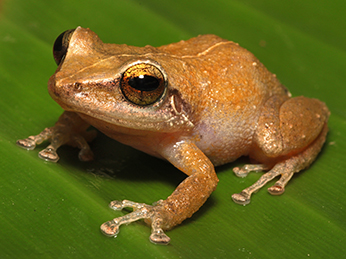By Nancy Greig, Director Emeritus, Cockrell Butterfly Center
As I was leaving the museum around 9 p.m. last week, after the fun “Evenings with the Owls” event at the Butterfly Center, my attention was piqued by an unfamiliar sound. It was a sort of double cheep, with the accent on the second cheep – I did not recognize it. (I think it’s interesting how we don’t consciously hear most background noises because they are familiar – but even subtle sounds stand out, if they are novel. Perhaps it is a good survival strategy.)
In any case, there were plenty of other sounds – cricket frogs, traffic, etc. – in the area, but I soon located the source of the cheeping, about 15 feet up in a large live oak tree. I was able to mimic it closely enough to get whatever was making the sound to answer back, and we called back and forth for a while. I was mystified. Was it a bird? Maybe. A frog? More likely. An insect? I wasn’t sure. So bringing modern technology to my aid, I pulled out my iPhone and recorded a short video – of blackness, since it was well after dark, but the sound recorded quite nicely. I posted the video to Facebook, flagging a couple friends who are bird and herp experts, asking for their opinion. Not five minutes later I got a reply that included a video and recording of the coqui, a small tree frog (Eleutherodactylus coqui) endemic to Puerto Rico. Several other FB friends concurred, and some also sent more recordings and photos. The mystery was solved!
Photo courtesy of California Fish and Wildlife
But not entirely. How did it get here? The coqui originated in Puerto Rico, but has been introduced to the Virgin Islands and Florida (in 1972), and in 1988, it arrived in Hawai’i (possibly in plant material from Florida). Since that accidental introduction, its populations in Hawai’i have exploded, especially on the big island. Some areas have as many as 10,000 frogs per acre, and the males’ incessant call, which continues throughout most of the night, is driving people crazy (and driving down real estate prices). In addition to being a major noise nuisance, all these frogs (in a place with no native amphibians, and few predators) almost certainly impact the delicate/fragile island ecosystem.
Eleutherodactylus is a very large genus of mostly small, usually brownish tree frogs (185 species, all in the New World tropics). All species have direct development – i.e., the eggs are not laid in water and there is no tadpole stage; the eggs hatch directly into tiny frogs). Most species show some form of parental care, males and/or females guarding the eggs or sometimes even the young froglets. Female coquis may be almost two inches long; males are somewhat smaller. In their native Puerto Rico, coquis are cherished and have become a national symbol.
None of my knowledgeable friends had heard of the coqui being reported from Texas, at least not from our area. However, Texas has one of the fastest growing Puerto Rican populations in the country. It’s not inconceivable that a recent immigrant inadvertently imported one of these frogs. Or perhaps a frog arrived in a shipment of plants from south Florida. I have not noticed the coqui’s call in any other part of Houston, but I will be keeping my ears open from here on out.
It’s unlikely that the coqui would become as big a nuisance here as in Hawai’i. There are plenty of local frogs and toads that would function as competitors, and plenty of predators (other frogs, lizards, birds, snakes) that will eat small frogs. Also, our area has the potential at least of having some freezing weather during winter months, although this has not happened recently. A significant cold snap would likely do in these tropical creatures. So it’s not clear if this is something to worry about. However, because of its impact in Hawai’i, the coqui is listed as one of the 100 most noxious invasive species in the world…
If you hear this call in your area, please let us know, or even better, send us a recording stating where you heard it. We’d like to help track the coqui’s presence here in Texas.






